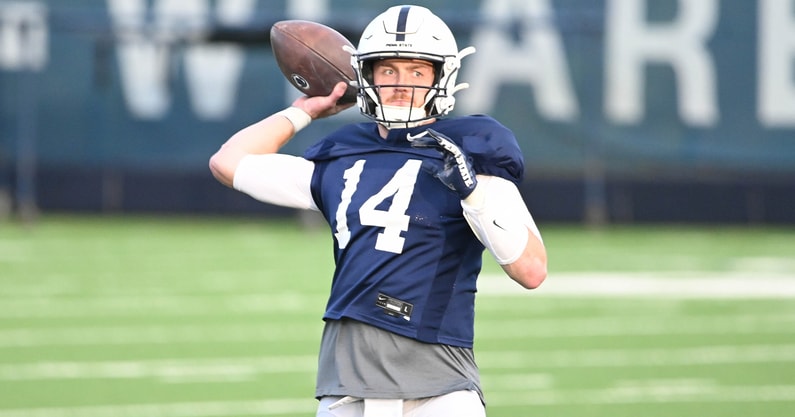Penn State crossroads a symptom of college football's larger issue: Column

The conversation surrounding Penn State football this week has been a fascinating and complex examination of balancing pros and cons. It is also, ultimately, missing the point.
The Nittany Lions, set to face Indiana on Saturday afternoon in Bloomington, are 6-2. To this point in the 2022 campaign, they’ve lost to No. 2-ranked Ohio State at Beaver Stadium and No. 5 Michigan at the Big House. In turn, Penn State is 15th in the initial College Football Playoff Rankings. Only LSU (10th), Kansas State (13th), and Utah (14th) are positioned higher with two losses.
But, with no realistic path to the playoff, a growing swath of fans and media covering the program are clamoring for a change at quarterback. Their collective sights set on 2023 and the possibilities therein, the argument stands that preparing for the future should take precedence over results in the final four games of the regular season and whatever bowl the Nittany Lions wind up playing.
Penn State head coach James Franklin, acknowledging and entertaining the discussion when meeting with the media on Tuesday this week, respectfully disagreed with the sentiment.
“We’ll continue to evaluate it like we always do. And I understand the question, I truly do. But it also comes off to me, when I’ve gotten that question multiple times, as if this game is not really important,” Franklin said. “So for us, we’re going to look at who gives us the best chance to be 1-0 this week and go from there. And whoever that is based on this week’s practice and preparation, we’ll go with. That’s really how it’s been all year long.
“I guess that is where I struggle a little bit with is there is still a ton of football left to be played, and whoever is going to give us a chance to be 1-0 this week and have a chance to win a bunch of games this year, for all the guys in the locker room, that’s who we’re going to go with. The question and similar questions like that I don’t necessarily love the tone of it. But I get it. To me, it’s an interesting question.”
The issue for Franklin and Penn State shouldn’t be that the question is being asked. The reality of college football today is that like it or not, the sentiment has much more credence than anyone who loves the sport would like to admit.
Beyond the responsibility or purview of Franklin, Sean Clifford, Drew Allar, or Penn State football, the legitimacy or the argument is, at heart, one of the overall state of the sport. That state, at present, is unequivocally broken thanks to its inability to evolve past the limited representation of the College Football Playoff model.
The first step since the Bowl Championship Series, an incredibly vapid system promising to pair the Nos. 1 and 2 teams for a national championship game by way of advanced math relying on human-ranked polls, the CFP is an undeniable improvement. But, in the eight years since it began, what’s become clear is that its influence over the sport has become paramount.
Four teams get to compete in a three-game tournament to decide college football’s champion. The ones who don’t make it, but are otherwise successful, get stuck playing an exhibition in which players, their families, and fans have come to realize were always overwhelmingly hollow and meaningless in the first place.
Top 10
- 1New
More departures?
Smith weighs in
- 2
Coaching search
Candidate comparison
- 3Trending
Joey Schlaffer
Leaves the Lions
- 4Hot
Buzzworthy
Search intel
- 5Live
Terry Smith
Wed. presser
Get the Daily On3 Newsletter in your inbox every morning
By clicking "Subscribe to Newsletter", I agree to On3's Privacy Notice, Terms, and use of my personal information described therein.
And now, because of it, the vast majority of college football fans, the coaches, the administrators, and players, are miserable. Needing to produce nothing short of an atypically flawless season, aided or dinged by random variants including conference scheduling philosophy, athletic director scheduling philosophy, and conference divisional alignment, even the 20 percent of the 130 FBS programs with any aspiration of reaching the playoff actually have no shot at all.
Over the past eight years, 13 teams have had at least one appearance in the CFP. Four have gone four-or-more times (Oklahoma, Ohio State, Clemson, and Alabama). Seven have gone just once (Michigan, Cincinnati, Washington, Michigan State, Florida State, Oregon, and LSU), and, for Notre Dame and last year’s champion, Georgia, the appearances number just two.
By comparison, only the New York Jets have not reached the NFL playoffs during the same period. And only five of the league’s 32 teams haven’t made the playoffs within the past four seasons.
While the fatigue felt toward Clifford this season is understandable, and the frustration of Penn State fans at another year spent without a playoff appearance is palpable, the reality is that in any other major modern American sport, this current conversation wouldn’t be happening with real stakes still on the line. But, without those stakes, with everyone having woken up to bowls’ illegitimacy, the argument will only grow louder in coming weeks.
In an arena where hope is the underlying foundation of sport, be it for the competitors themselves or the fans hoping to see their success, as constructed today, college football is, for all practical purposes, hopeless.
Productive change will come sooner rather than later as the Big Ten is set to eliminate divisions for the 2024 season and the CFP is working to expand to 12 teams as soon as then, according to the latest reports. For a sport whose stakeholders and fans deserve so much better, at Penn State and beyond, it will be welcomed.